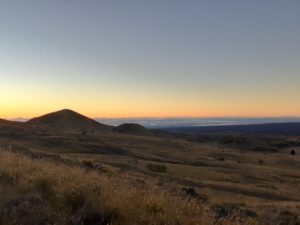Mauna Kea Summit Hike!

Mauna Kea Summit Hike
May 2020
Starting (on foot) Elevation: 9,200ft
Summit Elevation: 13,803ft
Mileage: 12
Challenges: Rapid altitude gain, steep gradient.
The Mauna Kea summit trail begins from the Mauna Kea visitor center. Turning off Saddle Rd to Mauna Kea, keep your eyes on the right where you will likely see you will see violets and oranges of the sunrise above the cloud line.

Upon arrival to the visitor center you will be greeted with a large parking lot on your right. This is the primary spot for acclimatization stops on Mauna Kea. If heading up on foot, one hour is recommended here. It is cold here (avg. 45F) in the early morning after sunrise, so it’s a great stop for some hot coffee to fuel up before the hike.

Once you’ve had your acclimatization time, pop by the visitor center to fill out a form required for those hiking. You can return the form to the same box and upon arriving back from the hike, write your return time on the form. Note the interesting cautionary signs of invisible cows on the wall to the left of this box. After leaving the visitor center, proceed up the paved road for about 10 minutes before taking the trail to your left, Humu’ula Trail (this is the summit trail). This dirt road section of the main trails continues for about 5 minutes before your reach a heli-pad and on the right, the true start of the Humu’ula Trail. The next 1-2 hours is perhaps the steepest section of the entire trail. There are small straights in between the steep gradient allowing you to catch your breath.

From here, it is pretty much a straight shot the rest of the way, except for the detour to Lake Waiau. The first couple of hours covers some of the most spectacular scenery on the mountain. The trail is clearly evident so even though in times of baron vegetation and rock you are free to focus on the surroundings.

After approximately 2 hours, the ground begins to shift from pebbly sand to larger rocks. At this stage you will know you are approaching the Adze quarry, where basalt rock was quarried by the ancient Hawaiians between 1000AD – 1400AD to make Adze axes and other tools.

From here continue for about another 1.5 hours where you will come across a triangular intersection. Approaching from the right is a trail coming from a parking lot off of the road, to the left is the Lake Waiau, and continuing up the mountain is the proceeding summit trail. Here it is definitely worth taking the very short detour to the left to see the lake. It is proximately .5 miles of a round trip detour. The lake holds sacred significance for the Hawaiian people so it is asked not to swim in the lake. There are a number of theories as to why the lake is actually here, ranging from glacial remains to volcanic sulphuric reactions.

After visiting the lake and returning to the junction, continue on the trail to the left, the summit trail. It is only a short distance until you stumble across the imposingly magnificent observatories. These are the lower observatories (from left to right in below image: Smithsonian, James Clerk Maxell, Subaru, Caltech – retired -, KECK Twins 1+2, and Nasa Infrared). This is perhaps one of the most mesmerizing points on the trail. If you are not familiar with them, it is a great idea to take a map of the telescopes with you so you can take into account which one is which and which seize telescopes, ranging from the .6 meter UH to the 10meter each of the Keck twins (the most astronomically advanced telescopes on the planet).

From here the footpath joins the road. You join the road and proceed around the hairpin bend on the last mile of the journey to the summit. One can start to feel the light effects of altitude here but the easy footing on the road is appreciated at this stage of the journey. Upon reaching the top of the road you are immediately met with the remaining telescopes. It is a quick hop over the road and to the right to continue on the trail to the true summit of Mauna Kea. This is also sacred land to Hawaiians so consideration of the area is greatly encouraged. The views from the summit are breathtaking.

After spending some time here it’s quite the treat to take your time frolicking among the giant telescopes. Telescopes in this location, from left to right are :UKIRT, UH Telescope, Gemini North, Canada-France-Hawaii telescope. The back (westward) side of the telescopes provides for great shelter from the wind so it serves as an ideal lunch spot and a great view over the Keck twins and Nasa telescopes.

The journey back down the mountain is an easy one. The steepest parts of the mountain are accompanied by a very soft, squishy, soil allowing you to stomp down the volcano in giant strides with little strain on your legs and knees. It is a long day, so chances are at this point it will be late afternoon, and if it’s not, it’s recommendable to delay a bit at the telescopes so you can descend in the golden sunset light across Mauna Kea.

Returning to the visitor center, be sure to pop the time back onto your hiking form, and proceed the chilled reward waiting in your car to reflect on the great day.

